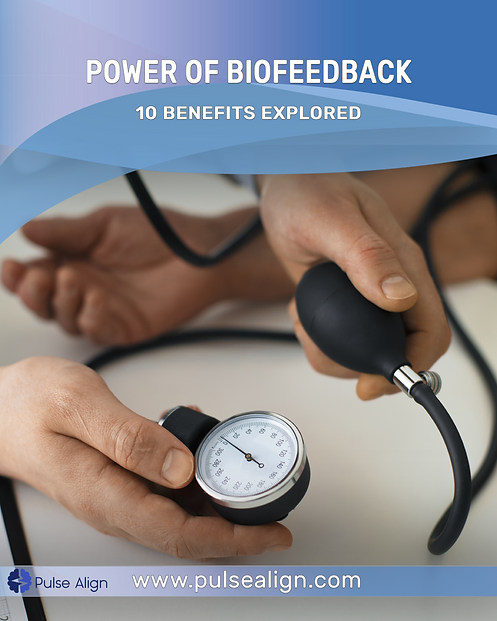In today’s fast-paced world, the quest for optimal health and well-being is more pertinent than ever. Amidst various wellness methodologies, biofeedback stands out as a revolutionary technique that enables individuals to harness the power of their physiological responses for enhanced health.
In this comprehensive guide, we delve into the profound benefits of biofeedback, with a special focus on the transformative potential of Pulse Align in addressing root causes rather than mere symptoms.
Understanding Biofeedback
Before we delve into its benefits, let’s grasp the essence of biofeedback. Biofeedback is a non-invasive therapeutic technique that empowers individuals to monitor and regulate their physiological processes. By providing real-time feedback about bodily functions such as heart rate, skin conductivity, and muscle tension, biofeedback enables individuals to gain insight into their body’s responses and learn to modulate them effectively.
Top 10 Benefits of Biofeedback
Stress Reduction and Relaxation
In today’s hectic lifestyle, stress has become a ubiquitous companion, wreaking havoc on our physical and mental well-being. Biofeedback offers a powerful antidote to stress by teaching individuals to cultivate relaxation responses. Through techniques such as deep breathing and mindfulness, biofeedback fosters a state of calmness and relaxation, thereby mitigating the detrimental effects of chronic stress on health.
Enhanced Emotional Regulation
Emotions play a pivotal role in shaping our overall well-being. Biofeedback equips individuals with the tools to better understand and regulate their emotional states. By monitoring physiological indicators of emotions, such as heart rate variability and skin conductance, individuals can develop greater emotional intelligence and resilience.
Improved Mental Focus and Clarity
In an age characterized by information overload and constant distractions, maintaining mental focus can be a daunting task. Biofeedback enhances cognitive function by training individuals to sustain attention and concentration. By learning to modulate brainwave patterns through techniques like neurofeedback, individuals can experience heightened mental clarity and acuity.
Pain Management
Chronic pain afflicts millions of individuals worldwide, significantly impairing their quality of life. Biofeedback offers a drug-free approach to pain management by teaching individuals to modulate their physiological responses to pain stimuli. Through techniques such as electromyography (EMG) biofeedback, individuals can alleviate muscle tension and reduce pain intensity effectively.
Enhanced Athletic Performance
Athletes constantly seek ways to optimize their performance and gain a competitive edge. Biofeedback emerges as a game-changer in the realm of sports performance by enabling athletes to fine-tune their physiological responses for peak performance. By optimizing factors such as heart rate variability and breathing patterns, athletes can enhance their endurance, agility, and overall athletic prowess.
Improved Sleep Quality
Quality sleep is essential for overall health and vitality, yet many individuals struggle with sleep disorders and disturbances. Biofeedback offers a holistic approach to sleep optimization by addressing underlying factors such as stress and anxiety. By promoting relaxation and stress reduction, biofeedback facilitates restorative sleep patterns, allowing individuals to wake up feeling refreshed and rejuvenated.
Enhanced Self-Awareness and Mindfulness
Self-awareness forms the cornerstone of personal growth and development. Biofeedback fosters greater self-awareness by illuminating the intricate interplay between mind and body. Through continuous monitoring and feedback, individuals gain insights into their physiological responses and behavioral patterns, paving the way for profound self-discovery and transformation.
Holistic Approach to Health
Unlike conventional approaches that often focus on symptom management, biofeedback embraces a holistic paradigm that addresses the root causes of imbalance and dysfunction. Pulse Align, a cutting-edge biofeedback technology, exemplifies this holistic approach by targeting underlying physiological imbalances and promoting natural healing mechanisms. By restoring harmony and balance to the body’s systems, Pulse Align facilitates a comprehensive pathway to optimal health and well-being.
Personalized Wellness Solutions
One of the hallmark features of biofeedback is its personalized nature. By tailoring interventions to individual needs and responses, biofeedback empowers individuals to embark on their unique journey toward wellness. Pulse Align takes personalization to the next level by leveraging advanced algorithms and machine learning to customize treatment protocols based on real-time physiological data, ensuring optimal outcomes for each individual.
Empowerment and Self-Efficacy
Perhaps the most profound benefit of biofeedback is the sense of empowerment it instills in individuals. By placing the reins of health and well-being squarely in their hands, biofeedback fosters a profound sense of self-efficacy and autonomy. Through diligent practice and commitment, individuals can cultivate resilience, self-mastery, and a renewed sense of vitality.
Conclusion: Embrace the Journey to Well-Being
In conclusion, biofeedback represents a beacon of hope in our quest for holistic health and well-being. By harnessing the innate intelligence of the body-mind system, biofeedback offers a transformative pathway to optimal living. With Pulse Align leading the way in addressing root causes and restoring balance to the body’s systems, the possibilities for enhanced well-being are limitless. As you embark on your journey towards greater health, consider embracing lifestyle changes and exploring the profound potential of biofeedback for a natural return to normal function and vitality.
Reference
Kondo, K., Noonan, K. M., Freeman, M., Ayers, C., Morasco, B. J., & Kansagara, D. (2019). Efficacy of biofeedback for medical conditions: an evidence map. Journal of general internal medicine, 34, 2883-2893.https://www.ncbi.nlm.nih.gov/pmc/articles/PMC6854143/
As the visionary CEO of Pulse Align, François is dedicated to transforming the landscape of pain management and posture health. With a deep-rooted passion for innovation and a commitment to excellence, François leads the team in developing cutting-edge solutions that empower individuals to live healthier, pain-free lives. Under his leadership, Pulse Align has become a beacon of hope and support for those navigating postural-related issues and chronic pain. François brings a wealth of experience in neuromodulation and patient management technologies, combining strategic insight with a compassionate approach to address the unique challenges faced by each individual.




